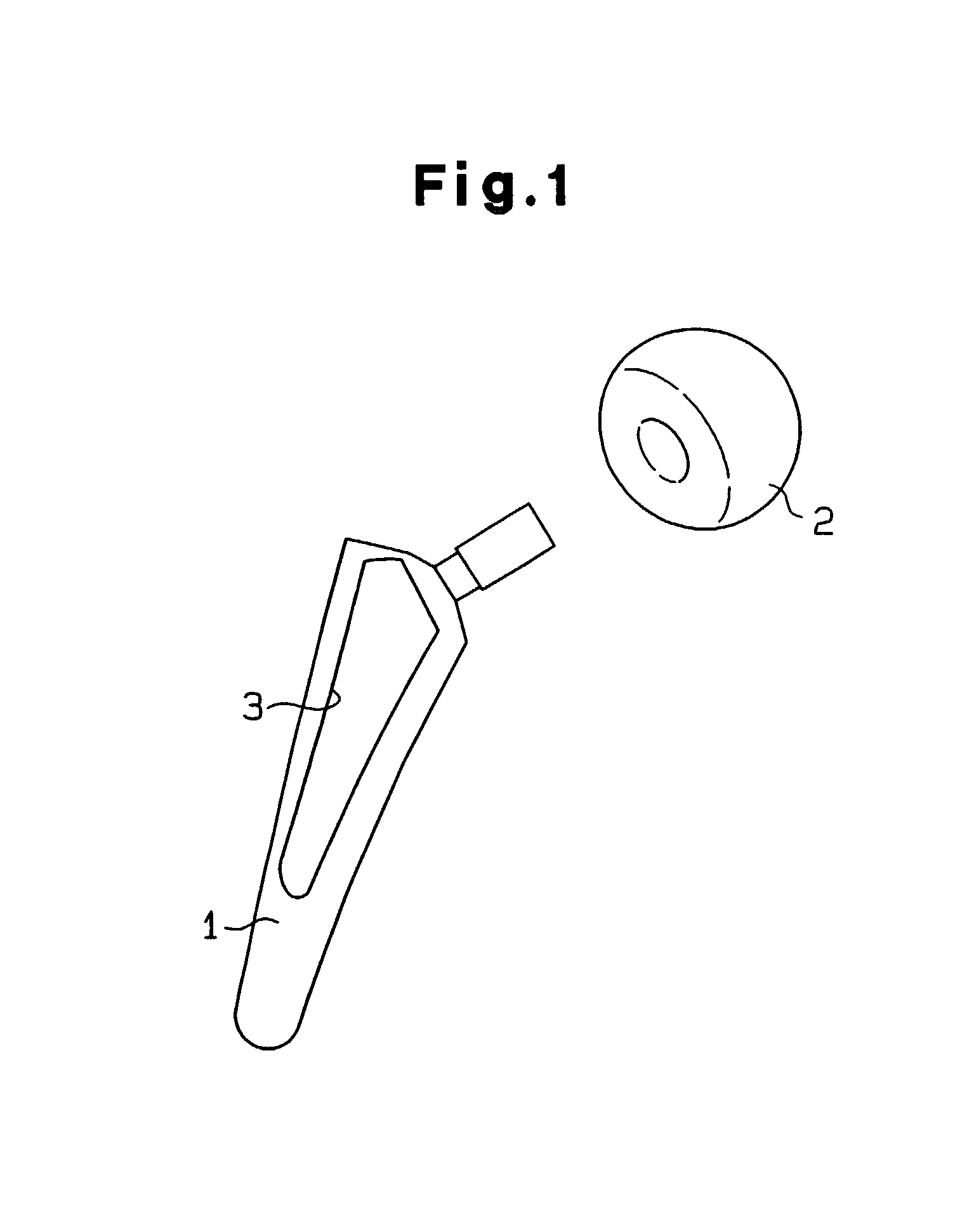Transplant material and method for fabricating the same
a technology of transplant material and material, applied in the field of bone tissue implants, can solve the problems of high heat of polymerization of pmma bone cement, serious damage to bone tissues, and the possibility of damage to living tissues of conventional artificial joints, so as to improve the repair speed and biocompatibility of bone tissu
- Summary
- Abstract
- Description
- Claims
- Application Information
AI Technical Summary
Benefits of technology
Problems solved by technology
Method used
Image
Examples
example 1
[0065]Marrow cells were obtained from a bone shaft of femurs of 7 week-old male Fischer rats, and α-MEM (minimum essential medium) containing 15% of fetal bovine serum (FBS) was added to the cells, and then obtained culture was primarily cultivated in an incubator (37° C., an atmosphere of 5% CO2) for 7–12 days.
[0066]After the primary culture, the cultured marrow cells were treated with 0.01% of trypsin solution, and 1×106 to 1×107 cells / ml of cell suspension was prepared. Disk artificial materials having a diameter of 34 mm and a thickness of 2 mm (made of titanium alloy, stainless steel, alumina ceramics and high-density polyethylene) were soaked in the suspension, and were incubated in an incubator for two hours (37° C., an atmosphere of 5% CO2). Porous artificial materials having a rectangular parallelepiped shape (3×3×5 mm) (made of titanium alloy, stainless steel, alumina ceramics and high-density polyethylene) were soaked in the suspension, and were incubated in an incubator ...
example 2
[0070]Marrow cells were obtained from an adult dog, and were primarily cultured for 7–12 days, as is like Example 1. After cultivation, a cell-suspended solution was prepared. The stem portion of the artificial hip joint composed of titanium alloy was soaked in the cell-suspended solution, and was incubated for two hours (37° C., an atmosphere of 5% CO2) Subsequently, the stem portion was transferred to a culture container containing culture medium identical to the medium used in example 1, and was cultured in an incubator (37° C., an atmosphere of 5% CO2) for about 1 week. If necessary, the medium was changed.
[0071]It was confirmed that the osteoprogenitor cells and the osteoblasts differentiated from the mesenchymal stem cells derived from bone marrow were adhered to the surface of the implant material, and the surface thereof was coated with bone matrix produced by these cells. In addition, when the stem portion of the artificial hip joint was implanted into a cavity of the femur...
example 3
[0073]2 ml of marrow cells were obtained from a humerus of a beagle dog having 12 kg of body weight. The obtained marrow cells were transferred to a tube containing 2 ml of FBS with heparin, and were centrifuged (900 rpm, 10 minutes, 24° C.) After fat cells and supernatant were removed from the centrifuged tube, cells were transferred to a T-75 flask, and were primary-cultured in a medium containing 15% of FBS and antibiotics for ten days. The culture medium was exchanged 3 times per week.
[0074]In this embodiment, an implant material having a stem 1 made of titanium (hereafter referred as “Ti”) and an artificial head 2 made of high purity alumina were used as shown in FIG. 1. Both surfaces of the stem 1 include associated recesses 3 (depth; 0.5 mm, area; 1.3 cm2). The implant material was treated with thermal spraying processing of pure Ti. Average surface roughness of the thermal spraying plane was 32 μm. After the primary culture, 0.25% of trypsin was used for detachment processin...
PUM
 Login to View More
Login to View More Abstract
Description
Claims
Application Information
 Login to View More
Login to View More - R&D
- Intellectual Property
- Life Sciences
- Materials
- Tech Scout
- Unparalleled Data Quality
- Higher Quality Content
- 60% Fewer Hallucinations
Browse by: Latest US Patents, China's latest patents, Technical Efficacy Thesaurus, Application Domain, Technology Topic, Popular Technical Reports.
© 2025 PatSnap. All rights reserved.Legal|Privacy policy|Modern Slavery Act Transparency Statement|Sitemap|About US| Contact US: help@patsnap.com

